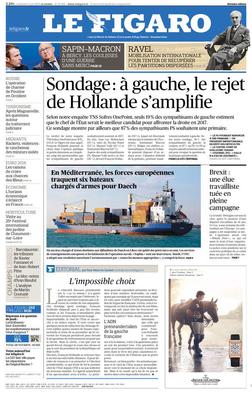
Le Figaro is a French daily morning newspaper founded in 1826. It was named after Figaro, a character in a play by polymath Beaumarchais (1732–1799); one of his lines became the paper's motto: "Without the freedom to criticise, there is no flattering praise".

Libération, popularly known as Libé, is a daily newspaper in France, founded in Paris by Jean-Paul Sartre and Serge July in 1973 in the wake of the protest movements of May 1968. Initially positioned on the far left of France's political spectrum, the editorial line evolved towards a more centre-left stance at the end of the 1970s, where it remains as of 2012.
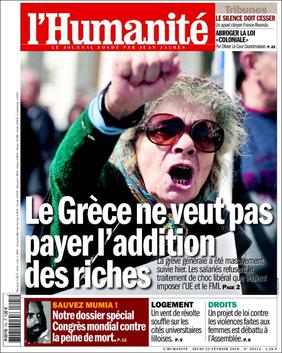
L'Humanité is a French daily newspaper. It was previously an organ of the SFIO, de facto, and thereafter of the French Communist Party (PCF), and maintains links to the party. Its slogan is "In an ideal world, L'Humanité would not exist."

Le Temps was one of Paris's most important daily newspapers from 25 April 1861 to 30 November 1942. It was a serious paper of record.
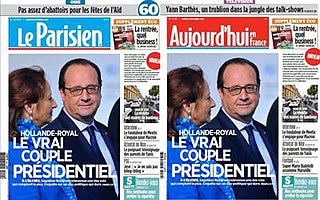
Le Parisien is a French daily newspaper covering both international and national news, and local news of Paris and its suburbs. Since 2015, Le Parisien has been owned by LVMH Moët Hennessy Louis Vuitton SE, better known as LVMH, belonging to French billionaire Bernard Arnault.

Diário de Notícias is a Portuguese weekly newspaper published in Lisbon, Portugal. Established since 1864, the paper is considered a newspaper of record for Portugal.

The modern newspaper is a European invention. The oldest direct handwritten news sheets circulated widely in Venice as early as 1566. These weekly news sheets were full of information on wars and politics in Italy and Europe. The first printed newspapers were published weekly in Germany from 1605. Typically, they were censored by the government, especially in France, and reported mostly foreign news and current prices. After the English government relaxed censorship in 1695, newspapers flourished in London and a few other cities including Boston and Philadelphia. By the 1830s, high-speed presses could print thousands of papers cheaply, allowing low daily costs.
Le Matin is a daily francophone Saudi-owned Moroccan newspaper. It was founded on 1 November 1971, as replacement of pro-colonial daily Le Petit Marocain, whose publisher Mas Presse was seized and given to the cousin of Hassan II and his minister of communication Moulay Hafid Alaoui.
Le Petit Journal was a conservative daily Parisian newspaper founded by Moïse Polydore Millaud; published from 1863 to 1944. Together with Le Petit Parisien, Le Matin, and Le Journal, it was one of the four major French dailies. In 1890, during the Boulangiste crisis, its circulation first reached one million copies. Five years later, it had a circulation of two million copies, making it the world's largest newspaper.
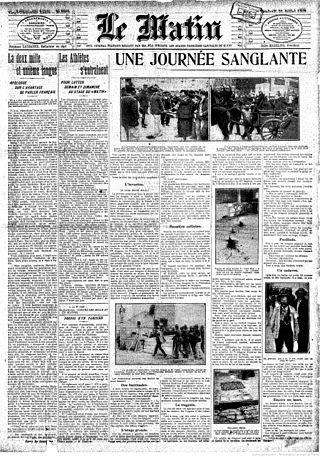
Le Matin was a French daily newspaper first published in February 26, 1884, and discontinued in 1944.
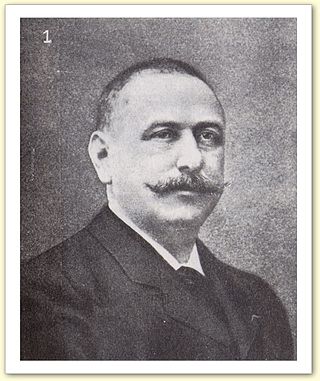
Pierre Giffard was a French journalist, a pioneer of modern political reporting, a newspaper publisher and a prolific sports organiser. In 1892, he was appointed Chevalier (Knight) of the Légion d'Honneur and in 1900 he was appointed an Officier (Officer) of the Légion d'Honneur.

L'Aurore was a French newspaper first sold on 11 September 1944, soon after the Liberation of Paris. Its name refers to the previous, unrelated publication, L'Aurore (1897–1914). Publication ended in 1985.
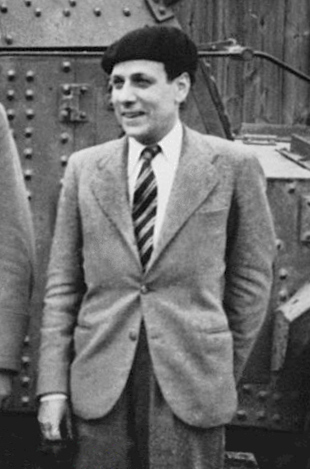
Claude Jeantet was a French journalist and far-right politician.

Newspapers have played a major role in French politics, economy and society since the 17th century.

Le Petit Provençal was a French provincial daily newspaper founded in Marseille in 1880. It took a Left Republican position, although it was never an official socialist organ. In the years before World War I (1914–18) many prominent politicians contributed to the paper. The paper opposed the pact between Germany and Russia just before World War II (1939–45), and after the fall of France opposed the Vichy regime. However, it managed to continue publication until 1944.
The history of journalism in the United Kingdom includes the gathering and transmitting of news, spans the growth of technology and trade, marked by the advent of specialised techniques for gathering and disseminating information on a regular basis. In the analysis of historians, it involves the steady increase of the scope of news available to us and the speed with which it is transmitted.
Mass media in Germany includes a variety of online, print, and broadcast formats, such as radio, television, newspapers, and magazines.

Andrée Viollis was a French journalist and writer. A prominent figure in news journalism and major reporting, she was an anti-fascist and feminist activist who was part of the French group associated with the World Committee Against War and Fascism. Viollis worked for various newspapers, including La Fronde, L'Écho de Paris, Excelsior, Le Petit Parisien, The Times, Daily Mail, Vendredi, Ce soir, and L'Humanité. She received several awards, including the Legion of Honour.

The clandestine press of the French Resistance was collectively responsible for printing flyers, broadsheets, newspapers, and even books in secret in France during the German occupation of France in the Second World War. The secret press was used to disseminate the ideas of the French Resistance in cooperation with the Free French, and played an important role in the liberation of France and in the history of French journalism, particularly during the 1944 Freedom of the Press Ordinances.















